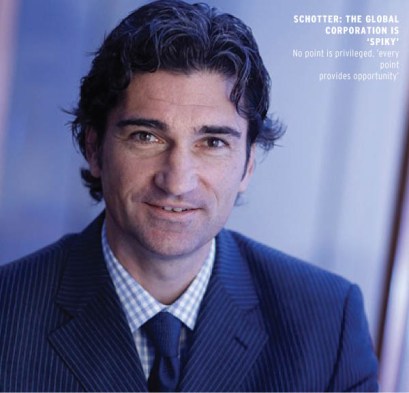BOUNDARY SPANNERS
THUNDERBIRD PROF ANDREAS SCHOTTER MAY HAVE DISCOVERED A SECRET TO REAL GLOBAL SUCCESS. HE CALLS THEM ‘BOUNDARY SPANNERS.’ YOU’LL CALL THEM ‘ESSENTIAL.’
Andreas Schotter is 45, six-foot-three and looks every bit the competitive rower he was when he won a silver medal for Germany in the World Games at 19, and represented Hong Kong in the scull just seven years ago. He describes corporate management in language lifted from the B-school vernacular, as well as from psychology, sociology and the human-potential movement. His accent reveals his German origins, but he also carries a Canadian passport. He’s got permanent-resident status in Hong Kong (lived there for 10 years) and (no mere academic wonk) he ran Asia-Pacific operations for a global manufacturing company, and later (with Indonesian-Chinese partners) owned a manufacturing business in Australia and China.
But at the moment, Dr. Schotter is in his office at Thunderbird School of Global Management in Glendale, Arizona. He’s talking about his path-breaking study of 150 multinationals, an investigation that ultimately revealed the presence in successful global firms of special managers. These “boundary spanners,” as he calls them, are men and women who transcend the everyday tug-of-war between parts of companies, individuals who “psycho-socially” (he says) bridge the boundaries (such as geographic, class, political, ethnic, religious, racial, sexual) that divide their organizations, and turn those divisions into opportunities for profit.
Part of the challenge of studying boundary spanners, of course, is that they don’t wear the title. You may find them almost anywhere in an organization’s upper management. And it’s almost impossible to put a cash value on their work. Still, through a complex series of measurements and a sample of over 150 name-brand global companies (with and without boundary spanners), Schotter says he and his colleagues have found strong support for one conclusion: “Organizational performance in the presence of boundary spanners is higher than for organizations without them.”
“Many executives like to think they live in a large multinational but homogenous family,” Schotter says, with the emphasis on family. “In reality, in many corporations there’s a competition between different subsidiaries for headquarters’ attention—for funds, for recognition, for support,” he says. “And this is the fault of the headquarters.” The solution is the boundary spanner, “someone who is able to facilitate transfers of knowledge and expertise despite the intrinsic counter-incentives”—counter-incentives like the me-first impulse, or what Schotter calls the “corporate never listens” response, these and similar barriers to the free-flow of information that bedevil every organization.
In last year’s “Performance effects of MNC headquarters-subsidiary conflict and the role of boundary spanners: The case of headquarter initiative rejection” (Journal of International Management), Schotter and co-author Paul W. Beamish list the sources of such “intra-organizational conflict,” beginning with “market and customer preferences, global and local competitors’ strategies, host-country and home-country regulatory requirements, strategic misalignments, asymmetries between local and global industry dynamics, managerial self-interests, psychosocial characteristics of managers at both headquarters and the subsidiaries, and many more.”
Many, many more: the kinds of hurdles you’ve encountered if you’ve worked for even a short time in a global company: distance, tradition, habit, race, gender, religiosity, culture, habit, prejudice . . . . You get the picture.
With his colleague Beamish, Schotter identified five characteristics of a boundary spanner: “high levels of what we call bipolar context understanding, high levels of professional expertise, strong and wide reaching social ties, awareness of the need for boundary spanning, and a global mindset.”
 But if you follow him in conversation—if you’re keeping track at home—Schotter adds other characteristics. That “high level of expertise,” for example, is probably responsible for creating what he elsewhere calls “legitimacy.” And then there’s “dual embeddedness” (that is, the boundary spanner has some work experience in his or her home-country subsidiary and at corporate HQ, wherever that is) and length of service (the typical boundary spanner “has been with the firm for a long time—between nine and 12 years”). In addition to a psychological profile characterized by “bipolar context understanding,” there’s the fact that boundary spanners “are not driven by money alone. Money is not even a key motivator. While they like monetary rewards, they are more driven by social rewards—trust, decision-making authority beyond their job responsibilities and fairness.” They generally have at least one second language, and often several. They’re highly educated, with many holding multiple degrees.
But if you follow him in conversation—if you’re keeping track at home—Schotter adds other characteristics. That “high level of expertise,” for example, is probably responsible for creating what he elsewhere calls “legitimacy.” And then there’s “dual embeddedness” (that is, the boundary spanner has some work experience in his or her home-country subsidiary and at corporate HQ, wherever that is) and length of service (the typical boundary spanner “has been with the firm for a long time—between nine and 12 years”). In addition to a psychological profile characterized by “bipolar context understanding,” there’s the fact that boundary spanners “are not driven by money alone. Money is not even a key motivator. While they like monetary rewards, they are more driven by social rewards—trust, decision-making authority beyond their job responsibilities and fairness.” They generally have at least one second language, and often several. They’re highly educated, with many holding multiple degrees.
When I suggest that the psycho-social stuff makes it sound as if boundary spanners are created in utero rather than in business schools, he agrees—sort of: “In the international context they are indeed somewhat ‘born,’” he says, and then stipulates that he is “not necessarily in favor of this term” (i.e., “born”) because “we have found evidence for nurture over nature or at least that boundary spanners’ personal traits have been influenced by certain psycho-social events early during their lives.”
“I have a manager in my sample,” Schotter says. “He works for the world’s leading manufacturer of prosthetics. He’s from London. His spouse lives in Paris. He works half in Germany and half in China; I don’t know how he does it. He’s truly a global manager. But he’s not a boundary spanner because he’s disbursed so much to different places. He’s a boundary spanner because of the way he addresses the needs of the business.”
What way is that? Boundary spanners, Schotter says, “look for the best solution at both ends of the headquarter-subsidiary dyad.” Sometimes that means the tail wags the dog—that corporate should adopt processes, procedures and products developed in a subsidiary. Sometimes it means the boundary spanner pushes back against headquarters if a headquarters initiative doesn’t make sense for the subsidiary or for the company at large. “But they also convince subsidiaries that there are HQ-initiatives that may not benefit the subsidiary but benefit the larger network.”
Schotter waves off the suggestion that boundary spanners are merely the latest iteration of what we used to call “expatriates.” Indeed, the word appears to sicken him slightly. “We need to get rid of the term ‘expatriate,’ he says. “It’s almost a colonial term. It really is top-down terminology.” An “expat,” he explains, was traditionally called in “to control foreign operations” or to transfer knowledge from the center to the periphery, from headquarters to the subsidiary. It was very one-way, and, “at one time, much needed and even very effective.” But times have changed, he says. What your organization really needs is a boundary spanner, a manager who can move information “from both ends—from headquarters to the subsidiary or from the subsidiary to the headquarters.”
Nor is a boundary spanner just someone who’s been around the planetary block a few times. “It’s not only that these people know how to speak Chinese in China, or Spanish in Mexico, or German in Germany.” Nor is it enough merely to be culturally sensitive, “to know that the Germans like to drink beer and the Chinese hand their business cards over with two hands. That’s not it. That’s just cultural awareness. The real deal is to understand the needs—how to think like a Chinese in China even if you’re not Chinese.” It is, he says, “about how you perceive others.”
And then Schotter zeroes in on his central point: “How we can be sure that my German boss understands that I’m not out here [in a subsidiary] creating an annoying hassle that divides the organization and disturbs global efficiencies. In fact, I have a huge opportunity that we can exploit not only here in the faraway market but potentially globally, even back in our home market in Germany.”
This is the place where Schotter becomes almost evangelical or maybe revolutionary in describing the implications of his observations. In his cosmology, the corporate world isn’t Thomas Friedman’s flat earth, but what Schotter calls “spiky”: no point in the company is a beginning or end, better or worse, a center or a point on the periphery. “But every point is unique and provides learning opportunities,” and learning—if you know your business professors—is where the corporate profit is.
The boundary spanner gets that, and is at ease in that spiky world. The boundary spanner “takes the learning from this market and transfers it across the network, eliminates dysfunctional conflict, creates inter-organizational trust, and nurtures transnational management efficiencies.”
The boundary spanner does all this, Schotter concludes—and this is key—“even without holding the highest level of formal power in an organization.”
“It helps if you understand the traditional models” of global corporate organization, Schotter says. “There are two basic patterns you can see. There’s the pattern of the headquarters as a controller of information, the master database. That’s very antiquated. Then there’s the other pattern of very dispersed information networks,” where the danger is that no one communicates with anyone else.
“These are the two extremes,” he says. What you want now, Schotter continues, is to “create hubs where people come together for information sharing.”
“’Hubs’ like a meeting?” you ask.
No, no: not a meeting, Schotter says, though that’s how global companies typically interpret it. “Usually what happens is that those meetings are extremely structured in firms: People come together, they report their data, and these reports are compiled and reported in such a way that everybody can be compared based on global standards only—the subsidiary in Brazil reports sales figures and gross figures and tells you maybe one or two interesting things that give some credit to the Brazilian subsidiary. Then the China manager steps up, and then the German. The next one is from South Africa, and then from Australia. At the end of the day, everyone has told his or her story but nothing new has been revealed. Nobody explained the underlying local business-execution stories.”
We don’t want that—these “one-directional meetings,” Schotter says. “The key here instead is to create communication opportunities that go outside these structured reporting self-promotion fests so that the manager from Brazil starts to know the manager from China at a personal level, and that they start to discuss the little problems offline.”
So, you suggest, why not create something at headquarters like the United Nations or the Galactic Senate in Star Wars where odd-looking creatures from distant planets sit in close proximity and resolve differences? Why not just bring managers from far-flung subsidiaries into the headquarters building to represent the interests of their subsidiaries? Call it the company’s Parliament of Boundary Spanners or something?
Schotter says that’s how most companies work today: they treat the subsidiaries as a minor league or development squad, drafting the most talented boundary spanners for a role in New York, London or Paris. The result, Schotter suggests, is often lose-lose. Those boundary spanners “lose their local embeddedness and their connections with those stakeholders who are located relatively farther away from the center of gravity in any firm. A global function creates very complex trade-offs and while understanding the overall organization is important the relative importance of the sub-unit for such a manager is being reduced. This includes the sensing abilities in each of the local contexts as well as the understanding of the local environments.”
In the end—literally: it’s in their conclusion to last year’s Journal of International Management article—it’s important to remember that conflict over boundary issues in a global organization is inevitable. But there’s hope. “Managing these dynamics within MNCs should not be regarded as a dilemma,” Schotter and Beamish write, “and global integration efficiency and local responsiveness effectiveness are equal sources of competitive advantage for MNCs. Those MNCs that achieve high levels of both are among the best performing.”
Or, as our Buddhist friends say, pain is inevitable, suffering is not: it’s possible to not merely tolerate boundary conflict but to transform it into something profitable.





Leave a Reply